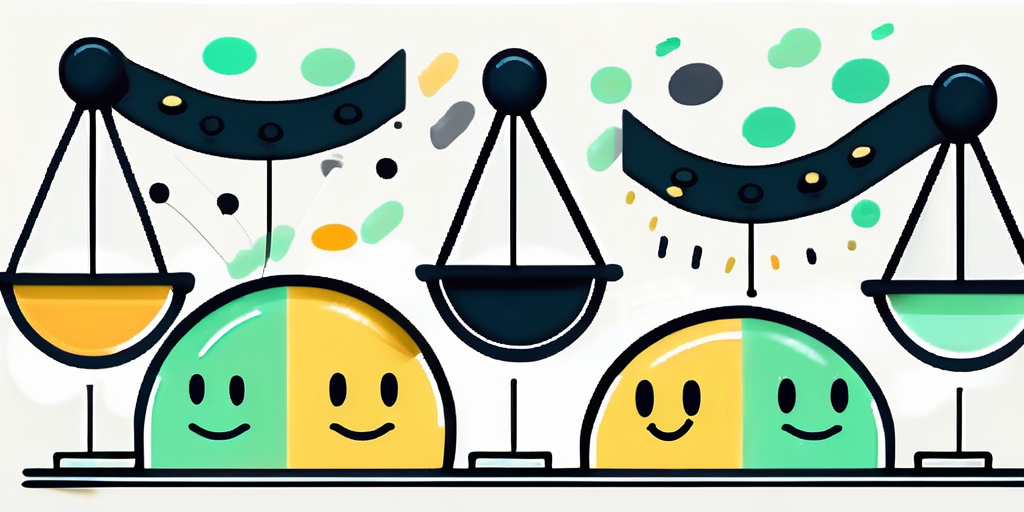Net Promoter Score: Customer Experience Explained
The Net Promoter Score (NPS) is a widely used metric in the field of customer experience management. It is a simple, yet powerful tool that measures customer loyalty and satisfaction. The NPS is based on a single question: "On a scale of 0-10, how likely are you to recommend our company/product/service to a friend or colleague?" The responses to this question are used to classify customers into three categories: Promoters, Passives, and Detractors.
The NPS was first introduced by Fred Reichheld, Bain & Company, and Satmetrix in 2003. Since then, it has been adopted by many organizations across different industries as a standard measure of customer loyalty. The simplicity of the NPS makes it easy to understand and implement, while its focus on customer recommendations reflects the importance of word-of-mouth in today's business environment.
Understanding the Net Promoter Score
The Net Promoter Score is calculated by subtracting the percentage of Detractors from the percentage of Promoters. The score can range from -100 (if every customer is a Detractor) to +100 (if every customer is a Promoter). A positive NPS is generally considered good, while an NPS of +50 is considered excellent.
 However, the NPS is more than just a number. It is a system that helps organizations listen to their customers, understand their needs, and take action to improve. The NPS provides valuable insights into customer loyalty, which is a key driver of growth and profitability.
However, the NPS is more than just a number. It is a system that helps organizations listen to their customers, understand their needs, and take action to improve. The NPS provides valuable insights into customer loyalty, which is a key driver of growth and profitability.
Categories of Customers
Customers are classified into three categories based on their responses to the NPS question. Promoters are those who give a score of 9 or 10. They are loyal enthusiasts who will keep buying and refer others, fueling growth. Passives are those who give a score of 7 or 8. They are satisfied but unenthusiastic customers who are vulnerable to competitive offerings. Detractors are those who give a score of 0 to 6. They are unhappy customers who can damage your brand through negative word-of-mouth.
Understanding the distribution of Promoters, Passives, and Detractors within your customer base is crucial. It helps you identify areas of strength and weakness, and provides a clear direction for improvement efforts.
Calculating the Net Promoter Score
The NPS is calculated by subtracting the percentage of Detractors from the percentage of Promoters. Passives are not directly included in the calculation, but they do affect the score as they can potentially become Promoters or Detractors.
The calculation of NPS is straightforward, but interpreting the score requires careful consideration. A low NPS does not necessarily mean that your business is failing, just as a high NPS does not guarantee success. It is important to understand the context behind the score and use it as a starting point for further investigation and action.
Benefits of Using the Net Promoter Score
The NPS is a powerful tool that provides several benefits. First, it is a simple and intuitive measure of customer loyalty. It is easy to understand and communicate, making it a useful tool for aligning the organization around a common goal.
 Second, the NPS provides actionable feedback. By asking customers why they gave a certain score, you can gain insights into what you are doing well and where you need to improve. This feedback can be used to drive continuous improvement and enhance customer satisfaction.
Second, the NPS provides actionable feedback. By asking customers why they gave a certain score, you can gain insights into what you are doing well and where you need to improve. This feedback can be used to drive continuous improvement and enhance customer satisfaction.
Customer Loyalty and Business Performance
Research has shown a strong correlation between NPS and business performance. Companies with a high NPS tend to have higher customer retention rates, lower customer acquisition costs, and higher revenue growth. This is because loyal customers are more likely to repurchase, refer others, and resist switching to competitors.
However, it is important to note that NPS is not a magic bullet. It is a tool that needs to be used in conjunction with other metrics and management practices. A high NPS is not an end in itself, but a means to an end: creating loyal customers who drive profitable growth.
Employee Engagement and Customer Experience
There is a strong link between employee engagement and customer experience. Engaged employees are more likely to deliver a positive customer experience, which in turn drives customer loyalty and NPS. Therefore, improving employee engagement can be an effective strategy for boosting NPS.
Many companies use the eNPS (employee Net Promoter Score) to measure employee engagement. The eNPS is based on a similar question to the NPS: "On a scale of 0-10, how likely are you to recommend this company as a place to work?" The eNPS provides a simple and actionable measure of employee engagement, which can be used to drive improvements in the workplace and enhance customer experience.
Challenges and Criticisms of the Net Promoter Score
Despite its popularity, the NPS has been subject to several criticisms. Some critics argue that the NPS oversimplifies the complexity of customer loyalty. They contend that loyalty cannot be reduced to a single number, and that other factors such as customer satisfaction, customer effort, and customer value should also be considered.
 Another criticism is that the NPS is not a predictive metric. It measures past behavior (recommendation likelihood) rather than future behavior (actual recommendations). Therefore, it may not accurately predict future growth or profitability.
Another criticism is that the NPS is not a predictive metric. It measures past behavior (recommendation likelihood) rather than future behavior (actual recommendations). Therefore, it may not accurately predict future growth or profitability.
Response Bias and Cultural Differences
One challenge in using the NPS is response bias. This refers to the tendency of respondents to give socially desirable answers or to avoid extreme responses. Response bias can distort the NPS and make it less reliable.
Another challenge is cultural differences. People in different cultures may interpret and respond to the NPS question differently. For example, in some cultures, giving a score of 9 or 10 may be considered excessive, while in others, giving a score of 6 may be considered very negative. Therefore, it is important to take cultural differences into account when interpreting the NPS.
Improving the Net Promoter Score
Improving the NPS requires a systematic approach. It involves listening to customer feedback, understanding the root causes of dissatisfaction, and taking action to address these issues. This process should be ongoing and integrated into the organization's daily operations.
One effective way to improve the NPS is to focus on the customer journey. This involves mapping out the different stages of the customer experience, identifying pain points, and finding ways to enhance the experience at each stage. By improving the customer journey, you can increase customer satisfaction, loyalty, and ultimately, NPS.
Conclusion
The Net Promoter Score is a valuable tool for measuring customer loyalty and driving business growth. It provides a simple, actionable measure of customer loyalty, and provides insights into customer needs and expectations. However, it is not a silver bullet. It should be used in conjunction with other metrics and management practices, and interpreted in the context of the business environment.
Despite its limitations, the NPS remains a popular and widely used metric in the field of customer experience management. By understanding and effectively using the NPS, organizations can enhance customer satisfaction, loyalty, and profitability.